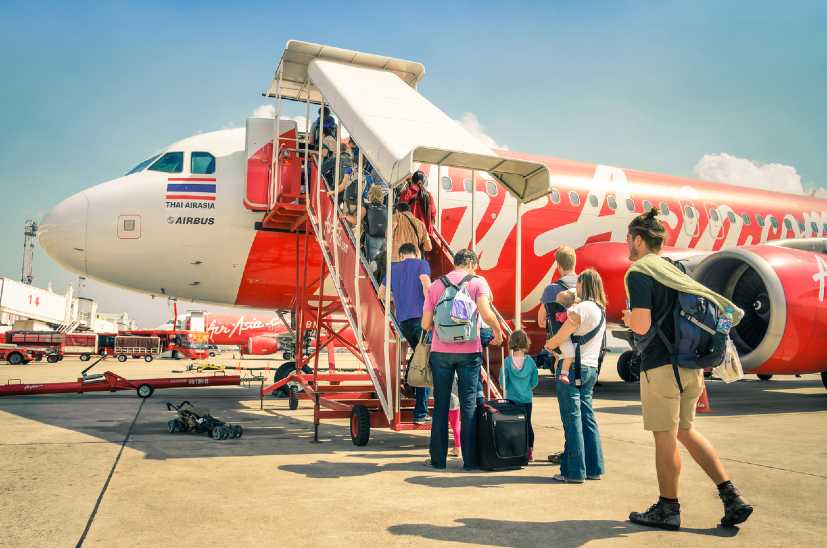Malaysian low-cost airline AirAsia is leveraging artificial intelligence and Internet of Things to reduce costs. These cost savings, an AirAsia company representative said, can be achieved across the entire gamut of operations be it on flight or on the ground.
Speaking exclusively to International Finance, the representative added that using advanced technologies was part of its digitisation strategy aimed at generating operational data that can be used to find better efficiencies. “The more things we can digitise, the better we can improve our efficiency and our operations,” he said.
With regard to the use of IoT, AirAsia has pre-installed some of its planes with over 1,000 sensors each. Using IoT, these sensors capture various operational and non-operational data, which is further analysed by the company to boost efficiencies. As an example, the representative said, sensors were being used to help in monitoring its aircraft engines to ensure they are not dirty as they could then end up burning more fuel, which would translate to increased spending for the company.
“Dirty engines consume more fuel, and while engine cleaning is regularly scheduled, monitoring the data allows for adjustments and cleaning. What we can do now is if an engine is starting to burn more fuel, we can go ahead and send it in for washing earlier. Now, we can be more proactive and these things will save us money,” the representative explained.
Apart from this, data received from these sensors is also being used to implement predictive maintenance, a tool built for the company’s defect analysts to determine what is to be done on specific aircraft component or systems prior to them becoming a failure. Such maintenance is said to help the company save costs as it aims to mitigate all operational disruption that could happen from technical delays and turn it into planned maintenance activities.
The representative explained that for every flight, these IoT sensors would help fetch up to 24,000 data parameters related to aircraft systems or component sensors. The data is obtained as soon as the aircraft power is switched on, after which it is transmitted on ground to the cloud server, then captured by the maintenance management systems and eventually analysed by the predictive maintenance machine learning algorithm to predict the failure of a specific target system, like for instance, the depletion of oxygen from the crew oxygen bottle.
IoT aside, the Malaysian airline is also using AI to save costs. In this regard it has partnered with American conglomerate General Electric to use its Flight Efficiency Services (FES) to help make its aircrafts more fuel efficient which helps save both costs and reduce its carbon footprint. This technology by GE, uses the power of the Industrial Internet to help AirAsia make significant savings, through the implementation of precision navigation services, flight data analytics, and fuel management services. The representative explained that the FES helps its airlines improve and follow better navigation routes, that are otherwise estimated to be about 20 percent inefficient across the industry, apart from also helping analyse flight data to optimise aircraft utilisation and fuel consumption. AirAsia forecasts that it will save between $30 million and $50 million over the next five years by using this technology.
Apart from using AI to save costs, AirAsia is also using it to boost efficiencies. One such example is its introduction of AVA (AirAsia Virtual Allstar), an AI powered chatbot that is part of its website and mobile app facelift. This was developed by the company using technology from Ada, a Toronto based company that specialises in AI-powered customer experiences.
The company representative said that this chatbot is aimed at delivering a more seamless, user-friendly experience to airasia.com and the app’s 3.3 million monthly active users, from flight bookings to browsing for deals to online shopping and customer support. AVA, which speaks eight languages, including English and Bahasa Malaysia is helping boost efficiencies by being available on the company’s new live chat feature and responding instantly to inquiries from guests.
Apart from AI and IoT, the company also uses other technologies such as biometric and facial recognition technology. An example is Fast Airport Clearance Experience System (F.A.C.E.S.), a technology that AirAsia introduced in 2018 in an effort to improve the boarding process of its guests.
The representative explained that F.A.C.E.S uses facial recognition technology to identify enrolled guests as they approach the automated boarding gate, allowing them to board their flight without having to present any travel documents, thus helping them save time. While this is already operational at Senai International Airport in the Malaysian city of Johor Bahru, it is expected to be rolled out soon at Malaysia’s Kuching Airport and Melbourne’s Avalon Airport.


